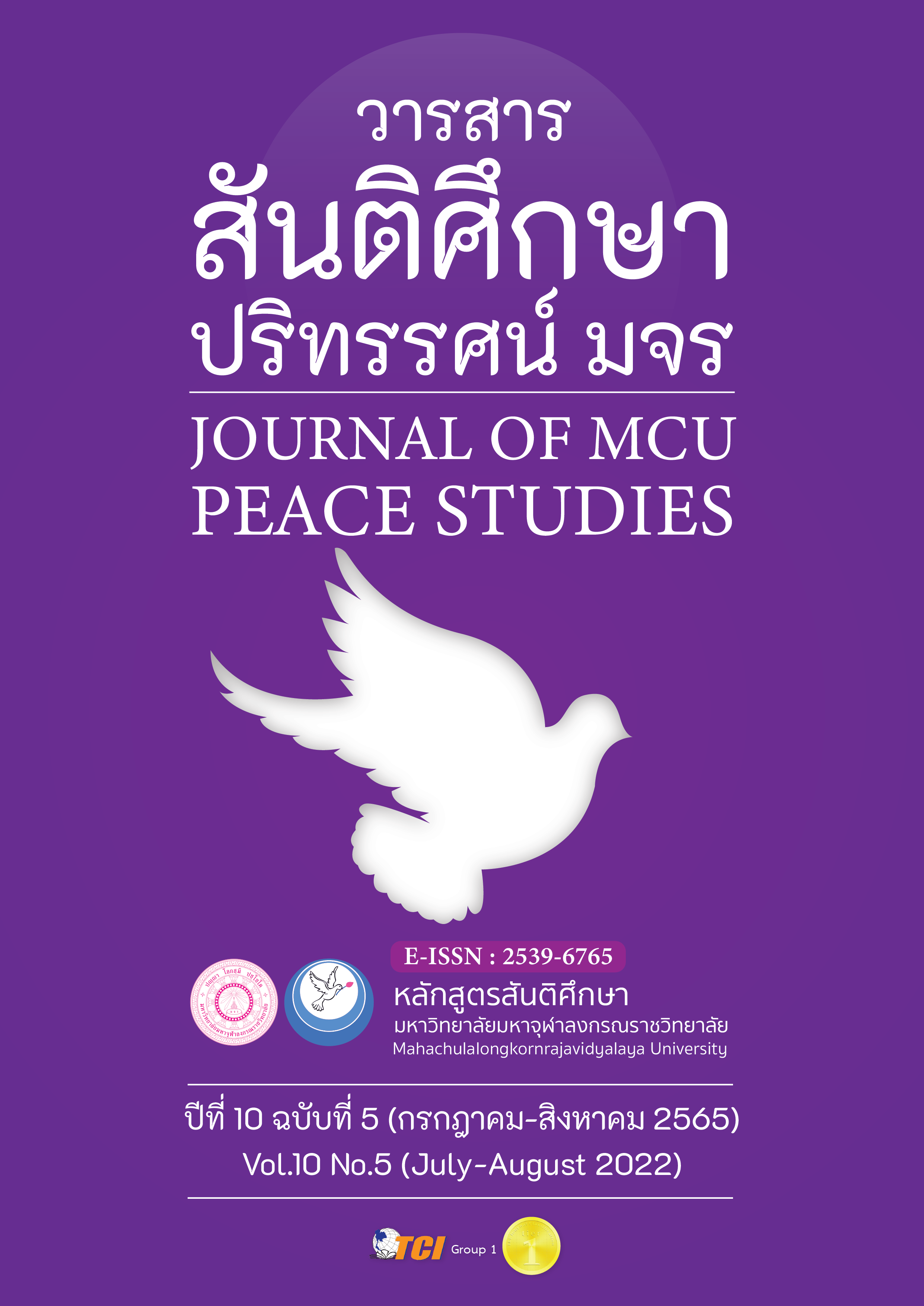การวิเคราะห์องค์ประกอบเชิงยืนยันภาพลักษณ์แหล่งท่องเที่ยวเชิงอาหารพื้นถิ่น จังหวัดภูเก็ต
Main Article Content
บทคัดย่อ
บทความวิจัยนี้มีวัตถุประสงค์เพื่อวิเคราะห์องค์ประกอบเชิงยืนยันภาพลักษณ์แหล่งท่องเที่ยวเชิงอาหารพื้นถิ่นจังหวัดภูเก็ต โดยระเบียบวิธีวิจัยเชิงปริมาณ กลุ่มตัวอย่าง คือ นักท่องเที่ยวที่มีประสบการณ์ท่องเที่ยวเชิงอาหารพื้นถิ่นในจังหวัดภูเก็ต จำนวน 370 คน จากจำนวนพารามิเตอร์ที่ต้องประมาณค่าในสัดส่วน 1 ต่อ 10 ใช้วิธีการเลือกกลุ่มตัวอย่างแบบเจาะจง ได้รับการตอบกลับ จำนวน 643 คน วิเคราะห์ข้อมูลด้วยการวิเคราะห์องค์ประกอบเชิงสำรวจและการวิเคราะห์องค์ประกอบเชิงยืนยัน
ผลการวิเคราะห์องค์ประกอบเชิงยืนยัน พบว่า โมเดลการวัดภาพลักษณ์แหล่งท่องเที่ยวเชิงอาหารพื้นถิ่นจังหวัดภูเก็ตสอดคล้องกลมกลืนกับข้อมูลเชิงประจักษ์ โดยมีค่าดัชนีความกลมกลืนดังนี้ ค่า χ2= 439.305, ค่า P-value = 0.63, ค่า χ2/df = 0.98, ค่า GFI = 0.97, ค่า AGFI = 0.96, ค่า RMR = 0.02, ค่า RMSEA = 0.00, ค่า CFI = 1.000 และ NFI = 0.98 องค์ประกอบภาพลักษณ์แหล่งท่องเที่ยวเชิงอาหารพื้นถิ่นจังหวัดภูเก็ต ประกอบด้วย 5 องค์ประกอบ ได้แก่ ความดั้งเดิมของอาหารและวิถีของคนในชุมชน (.951) คุณค่าแห่งการเรียนรู้ด้วยการบริการที่เป็นเลิศ (.909) กิจกรรมการท่องเที่ยวเชิงอาหารพื้นถิ่น (.899) คุณภาพและความปลอดภัยของอาหารพื้นถิ่น (.826) และสถานที่และสภาพแวดล้อม (.799)
Article Details

อนุญาตภายใต้เงื่อนไข Creative Commons Attribution-NonCommercial-NoDerivatives 4.0 International License.
ทัศนะและความคิดเห็นที่ปรากฏในบทความในวารสาร ถือเป็นความรับผิดชอบของผู้เขียนบทความนั้น และไม่ถือเป็นทัศนะและความรับผิดชอบของกองบรรณาธิการ ยินยอมว่าบทความเป็นลิขสิทธิ์ของวารสาร
เอกสารอ้างอิง
Bentler, P. M., & Bonett, D. G. (1980). Significance Tests and Goodness of Fit in the Analysis of Covariance Structures. Psychological Bulletin, 88(3), 588-606.
Castillo-Villar, F. R. (2020). Destination Image Restoration Through Local Gastronomy: The Rise of Baja Med Cuisine in Tijuana. International Journal of Culture, Tourism and Hospitality Research, 14(4), 507-523.
Chaiyasain, Ch. (2020). Phuket Street Food: STREET FOODS Model Providing a Creative Charm for Phuket’s Gastronomy Tourism. WMS Journal of Management Walailak University, 9(2), 120-127.
Choe, J. Y. J., & Kim, S. S. (2018). Effects of Tourists’ Local Food Consumption Value on Attitude, Food Destination Image, and Behavioral Intention. International Journal of Hospitality Management, 71, 1-10.
Churchill Jr, G. A. (1979). A Paradigm for Developing Better Measures of Marketing Constructs. Journal of Marketing Research, 16(1), 64-73.
Dickman, S. (1996). Tourism: An Introductory Text. (2nd ed.). Australia: Hodder Education.
Economics Tourism and Sports Division. (2020). Tourism Situation: November 2019. Retrieved April 12, 2021, from https://www.mots.go.th/download/article/article_20201229114033.pdf
Ellis, A., Park, E., Kim, S., & Yeoman, I. (2018). What is food tourism?. Tourism Management, 68, 250-263.
Hair, J. F., Anderson, R. E., Babin, B. J., & Black, W. C. (2010). Multivariate Data Analysis: A Global Perspective. Pearson Upper Saddle River. NJ, Pearson.
Hung, K., & Petrick, J. F. (2010). Developing a Measurement Scale for Constraints to Cruising. Annals of Tourism Research, 37(1), 206-228.
Jenasama, S., & Madhuri, S. (2018). Creative Tourism Through Food Activities in Thailand. International Journal of Management and Economics, 1(26), 25-30.
Kritchanat, S. (2019). Guideline to Creating Thailand’s Image as a Food Tourism Destination Among ASEAN Countries. The Journal of Social Communication Innovation, 7(2), 59-70.
Kline, R. B. (2011). Principles and Practice of Structural Equation Modeling. (3rd ed.). New York, NY: Guilford.
Lai, M. Y., Khoo-Lattimore, C., & Wang, Y. (2019). Food and Cuisine Image in Destination Branding: Toward a Conceptual Model. Tourism and Hospitality Research, 19(2), 238-251.
Lai, M. Y., Wang, Y., & Khoo-Lattimore, C. (2020). Do food image and food neophobia affect tourist intention to visit a destination? The case of Australia. Journal of Travel Research, 59(5), 928-949.
Manhas, P. S., Manrai, L. A., & Manrai, A. K. (2016). Role of Tourist Destination Development in Building Its Brand Image: A Conceptual Model. Journal of Economics, Finance and Administrative Science, 21(40), 25-29.
Mgonja, J. T. et al. (2016). A Structural Model to Assess International Visitors’ Perceptions About Local Foods in Tanzania. Journal of Sustainable Tourism, 25(6), 796–816.
Ministry of Tourism & Sports. (2019). Tourism Situation in 2019. Retrieved April 12, 2021, from https://www.mots.go.th/download/article/article_20201104090605.pdf
Office of the Nation Economic and Social Development Council. (2018). National Strategy. Retrieved April 30, 2021, from https://www.nesdb.go.th/ewt_w3c/ewt_news.php?nid= 7298&filename=
Phuket City Municipality (2016). Phuket: City of Gastronomy. Retrieved April 5, 2021, from https://www.phuketcity.go.th/news/detail/1701
Phuket Rajabhat University. (2021). Phuket Gastronomy Tourism: City of Gastronomy and Research of PKRU. Retrieved April 30, 2021, from https://www.pkru.ac.th/th/scoop/2599-unesco-phuket-city-of-gastronomy-may-2021
Polit, D. F., & Beck, C. T. (2006). The Content Validity Index: Are you sure you know what's being reported? Critique and Recommendations. Research in Nursing & Health, 29(5), 489-497.
Prasiasa, D. A. D. S. W., Kurniady, D. A., & Sutono, A. (2020). Interpreting Local Cuisine as a Tourist Attraction Klungkung City. Journal of Talent Development and Excellence, 12(1), 56-64.
Schumacker, R. E., & Lomax, R. G. (2004). A Beginner's Guide to Structural Equation Modeling. (2nd ed.). New Jersey: Publishers Mahwah.
Soonsan, N., & Somkai, U. (2021). Gastronomic Travel Experience Affecting on Sharing Experience: A Mediated-moderation Study. Chulalongkorn Business Review, 43(3), 40-63.
Sthapit, E., Björk, P., & Coudounaris, D. N. (2017). Emotions Elicited by Local Food Consumption, Memories, Place Attachment and Behavioral Intentions. Anatolia, 28(3), 363-380.
United Nations World Tourism Organization. (2019). UNWTO Tourism Definitions. Retrieved April 5, 2021, from https://www.e-unwto.org/doi/pdf/10.18111/9789284420858
Urry, J. (2002). The Tourism Gaze. (2nd ed.). London: Sage.


